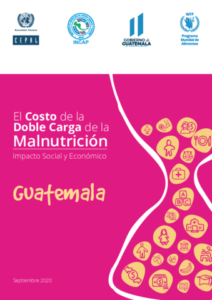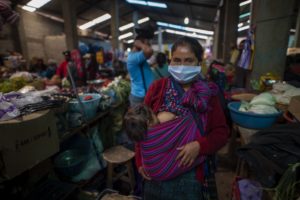The cost of malnutrition for Guatemala’s economy
Undernutrition, overweight and obesity cost Guatemala USD12 billion in 2018 amounting to a significant 16.3 percent of the country’s Gross Domestic Product (GDP), according to a report released today by the United Nations World Food Programme (WFP) and the Economic Commission for Latin America and…
Undernutrition, overweight and obesity cost Guatemala USD12 billion in 2018 amounting to a significant 16.3 percent of the country’s Gross Domestic Product (GDP), according to a report released today by the United Nations World Food Programme (WFP) and the Economic Commission for Latin America and the Caribbean (ECLAC). Resources lost to malnutrition take away from hard won development gains.
The Cost of the double burden of malnutrition: Economic and social impact in Guatemala – based on 2018 data – estimates that over US$8 billion is lost to the economic, social, and health related impacts of undernutrition, and another nearly US$4 billion to overweight and obesity – which is a growing concern for the country.
“Undernutrition, as well as overweight and obesity, are a huge burden for Guatemala and its people. We cannot ignore this evidence and we cannot afford to lose a significant chunk of valuable resources that could instead have supported development and prosperity,” said Miguel Barreto, WFP Regional Director for Latin America and the Caribbean. To respond to the challenge, Barreto said that “addressing the double burden of malnutrition in Guatemala must be a priority for all, because it affects everyone directly or indirectly.”
The report highlights that the health cost of undernutrition and related diseases alone totalled over US$365 million, which represents 45 percent of the total 2018 budget of the Ministry of Public Health. Likewise, the health cost of overweight, obesity and related diseases touched US$3.5 billion and is equivalent to four times the total 2018 budget of the Ministry of Public Health.
“In recent decades, the double burden of malnutrition is increasingly affecting the population of Latin America and the Caribbean, particularly the population in situations of poverty and vulnerability”, said Alicia Bárcena, Executive Secretary of ECLAC. “It is another factor in the existing inequality in our region, the repercussions of which are major, especially during the COVID-19 crisis.” Bárcena called on countries “to invest in public policies that lead to a crisis recovery based on the 2030 Agenda.”
In addition, the double burden of malnutrition negatively impacted the population’s intellectual development. According to the report, in 2018, more than 100,000 students had to repeat grades, with undernutrition affecting nearly 45 percent of them. Only 9 out of 100 children with undernutrition finished primary school.
It is estimated that the total cost for each time a student repeats a grade is about US$1000, of which nearly US$700 is absorbed by the education system and approximately US$300 by the family.
 “The next 25 to 30 years depend on our current actions to accelerate the reduction of malnutrition,” said the Secretary of the Secretariat of Food and Nutrition Security (SESAN) of Guatemala, Maritza Méndez. “We must act now so that the future working population is made up of healthy people, a population that has a better quality of life together with their families and communities.”
“The next 25 to 30 years depend on our current actions to accelerate the reduction of malnutrition,” said the Secretary of the Secretariat of Food and Nutrition Security (SESAN) of Guatemala, Maritza Méndez. “We must act now so that the future working population is made up of healthy people, a population that has a better quality of life together with their families and communities.”
The report was supported by the Institute of Nutrition of Central America and Panama (INCAP), the Ministry of Public Health and Social Assistance (MSPAS), and SESAN. It is part of a series of reports on malnutrition in Latin America and the Caribbean.
Download the study here (only available in Spanish)
